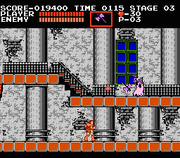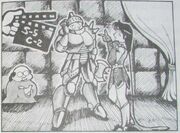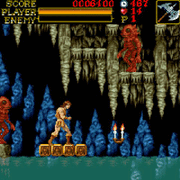Template:Infobox CVG Castlevania, known in Japan as Akumajō Dracula (悪魔城ドラキュラ Akumajō Dorakyura, lit. Devil's Castle Dracula) is the first game in the series of the same name. It depicts the exploits of a vampire hunter named Simon Belmont, who inherited a whip brimming with holy power from his father.
Because of an ancient blood feud between Simon's ancestors and the vampire, Count Dracula, it was Simon's calling to enter Dracula's castle and slay its landlord.
Castlevania was first released in Japan in September, 1986 for the Family Computer Disk System. In May, 1987, it was ported to the Nintendo Entertainment System and released in North America and then Europe in 1988. It was released again in Japan in 1993 for the Family Computer. Despite this, it was initially designed as a cartridge game in the first place before switching in the middle of development.[1]
Story
In the year 1691, Transylvania enjoyed a century of peace thanks to the legendary hero, Christopher Belmont, a vampire hunter who vanquished Count Dracula one hundred years earlier with a holy whip named Vampire Killer. The people of a Transylvanian village were enjoying their fortune with an Easter celebration in honor of the resurrection of Jesus Christ, but every one hundred years, the power of Jesus weakened, and the hearts of men turned black as they yearned for chaos and destruction. During this time, they sought to revive Count Dracula so he may spread chaos and ruination throughout the world. While the Easter celebration carried on with a grand carnival, evil men gathered in a monastery at the edge of the village and conducted a black mass to resurrect Count Dracula. [2]
The men succeeded in bringing their master back in 1691. A bolt of lightning enveloped the monastery where they held the rite, signaling the resurrection of Count Dracula. When the Count returned, his Castle, which had fallen one hundred years prior, reappeared in Transylvania, and his legions of loyal minions reformed. [2]
Simon Belmont, the descendant of Christopher Belmont, knew that as a member of the Belmont Clan and the current wielder of the Vampire Killer whip, it was his duty to bring peace and stability back to Transylvania by destroying Dracula. The Count was said to grow in strength with each resurrection, but Simon pressed on. He took the very same whip Christopher used to kill Dracula one hundred years before and entered the Castle alone. [2] Simon proved himself a mighty vampire hunter by withstanding the monsters and traps of Dracula's Castle, and in the end, destroying Count Dracula himself.
Though Simon prevailed in ridding the world of the scourge of Dracula, he was terribly wounded by Count Dracula in the process.
Gameplay
Castlevania consists of six linear stages with a boss at the end of each stage. The stages represent areas of Dracula's decrepit castle, and the enemies are typically taken from horror literature, lore, and film. Castlevania is an action platformer that emphasizes precision and timing. Throughout stages are pits and other traps that cause instant death. Many enemies will try to take advantage of these, as Simon is pushed back when he suffers damage. As players progress further into the game, the enemies will deal greater damage, eventually to the point where Simon will be killed after taking four hits.

Simon Belmont attacks zombies with an axe.
Simon's primary weapon is his whip – Vampire Killer. Vampire Killer can be upgraded to boost attack strength and length. Upgrades and items are found by striking candelabras or killing enemies. Aside from the whip, Simon uses sub-weapons that have varying affects, such as the boomerang, which Simon throws straight ahead and crosses the length of the screen before returning to the point where it was thrown, and the Stop Watch, which halts enemy movement for a short period of time. These sub-weapons cost hearts to use. Simon can only carry one sub-weapon at a time.
Players are rewarded with points for killing enemies and clearing a stage. The amount of points gained at the end of a stage depends on how quickly it was completed. Extra lives can be earned through gaining enough points.
After beating the game, players return to the first stage while retaining their weapons and score. This time, however, they face stronger enemies. Players often refer to this as a "second quest" or "hard mode".
Characters
(Simon Belmondo) |
Simon Belmont is a 22 year old Vampire Hunter, and a descendant of Christopher Belmont, the legendary hero who killed Count Dracula in 1591. When the family's nemesis resurrected yet again due to a black mass ritual conducted by a group of cultists, Simon takes the mysterious whip passed down to him from his father, and sets out to seal away the evil vampire.[3][2] | |
| The Prince of Darkness. The last time he was brought back into the world, it was completely covered in darkness, but his ambitions were crushed when Christopher Belmont set out to defeat him. Peace returned to the countryside of Transylvania for one hundred years, but when exactly one century had passed, the power of Christ weakened, and the hearts of men turned black, praying for the resurrection of Count Dracula. He rests in the castle's highest floor, awaiting the arrival of the Belmont Clan.[2] | ||
Music
The very first soundtrack in the series was composed by Kinuyo Yamashita (with Satoe Terashima[4]), which is her only score provided for the series. Castlevania was both her first project while employed at Konami, and first composing experience. It is also one of her favorite works. She was credited as "James Banana", a parody of James Bernard, the composer of the 1958 film Dracula.
The music of the game has been commercially released several times and is featured in CDs like Akumajō Dracula Famicom Best (1990), Castlevania 20th Anniversary Deluxe Music Collection (2006), and Akumajō Dracula Best Music Collections BOX (2010). Some of the tracks are rearranged and featured in CDs like Perfect Selection Dracula Battle (1991) and Perfect Selection Dracula ~New Classic~ (1992).
Popular pieces from the production include Vampire Killer, which became a frequently recurring tune in the franchise, and Wicked Child. Many of the tracks found in the game were remixed and used in later titles.
Cinematic Reference
Castlevania is known for drawing inspiration from several old horror movies made roughly in the first half of the 20th century. Enemies and bosses are sometimes directly taken from these movies, like Frankenstein's Monster and Dracula, while others are based on horror movie icons like mummies and ghosts.
The obvious classic horror atmosphere is further emphasized by displaying the start screen as a movie reel and adding fake movie credits at the end of the game.

A scene from The Devil Castle Dracula: The Battle of Old Castle.
One of the movies that inspired the character of Dracula to be included was Horror of Dracula (1958). Both the names of the director Terence Fisher and the actor Christopher Lee are parodied in the game. The original Dracula film (1931) with Bela Lugosi was most likely also drawn from, as both the film and Castlevania are set in Transylvania, while the 1958 version takes place in Klausenberg. Bela Lugosi is also mentioned in the credits, but only as the actor of the Grim Reaper rather than Dracula.
Another important reference is the presence of the Creature from the 1931 American horror film Frankenstein with Boris Karloff. Glenn Strange (who also played the Creature) is referred to in the mock credits, but, just like Bela Lugosi, is not credited for his most famous role and instead plays the part of the Fish Man. The monster is accompanied by the hunchback Igor, supposedly portrayed by Lon Chaney, while his son is mentioned to be the Mummy Man.
Although the character of Medusa is from Greek mythology, she also has a corresponding film. Namely, The Gorgon (1964). However, the Gorgon who appears is not Medusa, but her sister Megaera.
The Japanese Castlevania choose-your-own-adventure book The Devil Castle Dracula: The Battle of Old Castle takes the cinematic inspiration even further. In the game book, a movie is being shot in Dracula's castle by a descendant of Simon Belmont during the 1950's. The one of fake actors mentioned in the credits of the game, Christopher Bee, also plays a part.
Credits
The staff and cast in the ending credit are parodied of many individuals famous for their roles in horror or monster films. They are as follows:

The end credits of Castlevania (click to watch)
- Terence Fisher (Trans Fishers)
- Bram Stoker (Vram Stoker)
- James Bernard (James Banana)
- Christoper Lee (Christopher Bee)
- Bela Lugosi (Belo Lugosi)
- Boris Karloff (Boris Karloffice)
- Lon Chaney (Love Chaney)
- Lon Chaney, Jr. (Love Chaney, Jr.)
- Barbara Shelley (Barber Sherry)
- Max Schreck (Mix Schrecks)
- Glenn Strange (Green Stranger)
- Oliver Reed (Cafebar Read)
- André Morell (Andre Moral)
- John Carradine (Jone Candies)
Regional Variations and Re-releases
For further information, please see Castlevania (home computer), VS. Castlevania and Castlevania (cell phone game).
Two different Japanese versions of Castlevania exist, which both differ slightly from their American and European counterparts. The original Akumajō Dracula released for the Famicom Disk System has a name-entry that allows the player to save his game. It also features an unique music track that can also be heard when entering a name in Castlevania: Harmony of Dissonance. The spots where candles are placed are also different and make it possible to collect powerful whip upgrades much earlier; making the game somewhat easier than other versions.

A Castlevania adaptation for cellphones.
In 1993 Konami re-released Castlevania as a Famicom cartridge. In this version it is possible to select between a "Normal" or "Easy" difficulties.
Castlevania has been ported to many different platforms since its initial release with some notable differences. 2004 saw the release of Castlevania on the Game Boy Advance as part of the Classic NES Series. The ending credits were removed and it added a save feature.
In 2007, it was released through the Wii Virtual Console. Upstart Games ported Castlevania to mobile phones in 2002 and upgraded it in 2004 with enhanced graphics, and an even better version was produced in 2004, but released only in Japan.
Konami Collector's Series: Castlevania & Contra, released in 2002 for the PC, is a collection of five Konami hits from the days of the Nintendo Entertainment System: Castlevania, Castlevania II: Simon's Quest, Castlevania III: Dracula's Curse, Contra and Super C. Additionally, the CD contains a Dance Dance Revolution demo. This package was released in October of 2006 and re-released for the download service GameTap. All of the games are perfect emulations of their NES counterparts; the only changes of note are the text differences found in Simon's Quest and the option to perform a quick save.
Other notable re-releases include:
VS. Castlevania - PlayChoice-10
- There are minor palette differences, most likely due to the differences between a TV screen and an arcade monitor.
- VS. Castlevania is more challenging due to the increased difficulty levels. It is also possible to select a Hard Mode in which enemies can kill Simon with just a few hits.
- Up to 99 continues can be bought by inserting credits.
- The PlayChoice-10 version has no increased difficulty, but does have the same slight color differences.
- The game contains a very primitive help screen.
- The player is only allowed to play for a limited amount of time before another game is picked.
IBM PC Compatible - Commodore 64
- Developed by Unlimited Software.
- The graphics and the music have been considerably downgraded to meet the standards of the corresponding systems.
- The sound effects are completely different.
- It is possible to continue a saved game.
- The regular boss theme is absent in both versions.
- The projectiles of bosses can be frozen with the Stopwatch.
- The PC version contains an additional shot of a cemetery in the intro.
Commodore Amiga
- Developed by Novotrade.
- The game contains enhanced graphics and music.
- The sound effects are completely different.
- It is possible to continue a saved game.
- The regular boss theme is absent.
- Some tunes are assigned to completely different stages.
Trivia
- Belmont's pose on the game's cover appears to be inspired by the Norseman by Frank Frazetta.
(1972)
Miscellaneous
Related Games
- Vampire Killer - (known in Japan as Akumajō Dracula) is an alternate version of Castlevania and was developed alongside it.
- Castlevania II: Simon's Quest - (known in Japan as Dracula II: Seal of the Curse) is the sequel to the first Castlevania game.
- Haunted Castle - (known in Japan as Akumajō Dracula) is the first Castlevania game released for arcades. This game also stars Simon Belmont as revealed by a help video.
- Super Castlevania IV - (known in Japan as simply Akumajō Dracula) is the first of two Castlevania games released on the Super Nintendo Entertainment System console. The game's protagonist is also Simon Belmont and its story has the same setup.
- Castlevania Chronicles - (known in Japan as Castlevania Chronicle: Akumajō Dracula) is the enhanced remake of Akumajō Dracula (Sharp X68000).
Other Related Products
- Akumajo Dracula Perfect - A Japanese guidebook covering Castlevania.
- The Official Nintendo Player's Guide - Contains coverage for Castlevania.
- NES Game Atlas - A guide containing stage maps for Castlevania.
- The Devil Castle Dracula: The Battle of Old Castle - A licensed choose-your-own-adventure novel that features Simon's descendant, also called Simon.
- Akumajō Dracula Famicom Best - Contains the Castlevania original soundtrack.
- Akumajō Dracula Best Music Collections BOX - Contains music from Castlevania on Disc 1.
- Famicom Rocky - A manga featuring Castlevania.
See also
External links
- Castlevania at the Castlevania Fan Wiki
- Konami Mobile (Japanese)
- Konami Mobile The Complete Edition (Japanese)
- Konami Wii Product Page (Japanese)
References
- ↑ http://www.glitterberri.com/developer-interviews/konamis-nintendo-games/
- ↑ 2.0 2.1 2.2 2.3 2.4 Akumajō Dracula instruction manual. Konami. 1986. p.4, 5, 6, 7. KDS-AKM.
- ↑ Ultimate Judge Guidebook. Shueisha. 2009.
- ↑ The Legacy Music Hour - Episode 36 Kinuyo Yamashita
| Castlevania | |
|---|---|
| Characters | |
| Simon Belmont • Dracula | |
| Bosses | |
| Phantom Bat • Queen Medusa • Mummy Man • Frankenstein & Igor • Grim Reaper • Count Dracula • Spirit of Dracula | |
| Stages | |
| The Castle Entrance • The Chapel • The Castle Ruins The Catacombs • The Dungeons • The Clock Tower and the Castle Keep | |
| Music | |
| Underground • Vampire Killer • Stalker • Wicked Child • Walking on the Edge • Heart of Fire • Out of Time Nothing to Lose • Poison Mind • Black Night • Voyager • Akumajō Dracula Famicom Best | |
| Guides | |
| Akumajō Dracula Perfect • The Official Nintendo Player's Guide • NES Game Atlas | |
| Archives | |
| Bestiary • Inventory | |





